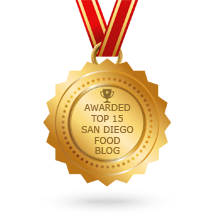My 2016 Thank You Notes
It would be an understatement to state how tumultuous 2016 was for me. Losing a parent slowly and painfully--and finally, permanently--to dementia takes its toll. It'll be awhile before I'm truly back to my life. Even so there still were a lot of bright spots. There were big-hearted friends who made sure I was doing okay by bringing me food or yanking me out to the occasional movie. And there was my work. How could there be a totally bad day if I got to spend part of it in the kitchen with a chef?
So, I'd like to end the year by thanking all the chefs who over the past 12 months invited me into their most sacred space and taught me a recipe, a skill, a neat trick for me to share with readers.
Thanks to Quinn Wilson of Balanced and Bright, who invited me into her home to teach me about her bone broth and demonstrate how to make her Autumnal Pork Stew. It would be so lovely to have a bowl of that right now!
Thanks to the energetic Teri McIllwain of Chandler's Restaurant at Cape Rey Carlsbad. She made me her Farro Stir Fry filled with plump shrimp.
From Junya Watanabe of Rakiraki Ramen & Tsukemen, I learned a terrific version of poke that's fresh and flavor popping. Thanks, Junya!
Moto Deli's chef Andrew Halvorsen taught me how to make their rich Moroccan Meatball Sandwich from their food truck. Congrats on completing the new deli! And thank you and Alex Carballo for the experience!
Thank you, Christine Rivera of Galaxy Taco, for teaching me how to make your fabulous Brussels Spouts in the Style of Elotes!
Chefs move around so much! This thank you goes to my friend Anthony Sinsay, who earlier this year was running the kitchen at Duke's and made me his stunning Mussels Adobo. Now he's ensconced at JSix and my story on how he forages in his kitchen will run in the San Diego Union-Tribune next week.
I love Bottega Americano, so it was a huge treat to have Chef Jeremy Oursland invite me to come in and learn how to make his Salmon with Vegetables, Gnocci, and Tomato Fonduta. Thanks, Jeremy!
Chocolatiers are a special breed. Michelle Lomelin of Sweet Petite Confections fits right in with her mix of precision and whimsy. Thank you, Michelle, for taking the time to teach me how to make your bonbon, The Earl and the Tarts.
Oh, my friend Maeve Rochford! I love Sugar and Scribe and loved our time together in your kitchen, learning about the Irish Halloween tradition of Tea Bramback! So good!
Finally, there's Lorne "The Hammer" Jones, whom I met through the training program Kitchens for Good. The Hammer has worked hard to reach the goal of becoming a certified baker and is now baking at Panera. The day we got together he taught me how to make a family favorite, Pineapple Upside Down Cake--only miniature versions. They were divine. Thanks, Hammer, and good luck to you!
I also want to thank Bob Harrington, Kelly Orange, and Specialty Produce for their always generous support--of this space, of my Close to the Source blog for Edible San Diego, and of the community projects I work on. They are smart and far-sighted people--and beyond kind. And, thanks as well to Tommy Gomes and Dave Rudie of Catalina Offshore Products for being my seafood gurus, community teachers, and just great pals. Thanks to the many farmers, farmers market managers, and artisan vendors who always take the time answer my many questions and share their knowledge and bounty with me so I can help our community better understand what they do. Thanks to the many restaurant owners and chefs who are working so hard to put San Diego's best on the table and do it responsibly--and clue me into their efforts. And, last but not least, I thank you for taking the time to read San Diego Foodstuff and sharing it with your friends. It means a lot.
Thank you all for pulling and tugging me through 2016 with your love and concern. It has meant more than you will know.
I'm looking forward to more kitchen fun with chefs in 2017, but in the meantime, I wish all these chefs, vendors, farmers, and their loved ones, as well as you, a very happy, healthy, and joyous New Year!
Print Page

































